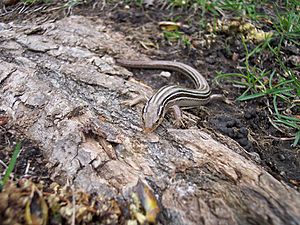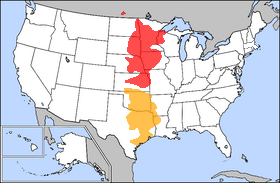Prairie skink facts for kids
Quick facts for kids Prairie skink |
|
|---|---|
 |
|
| Conservation status | |
| Scientific classification | |
| Subspecies | |
|
P. s. septentrionalis |
|
 |
|
| Northern (red) and southern (gold) prairie skink ranges | |
| Synonyms | |
|
Eumeces septentrionalis |
The prairie skink (Plestiodon septentrionalis) is a type of lizard found in the prairies of North America, east of the Rocky Mountains. It's one of only seven kinds of lizards that live in Canada. These skinks are special because they are endemic to this area, meaning they naturally live only there.
Contents
About the Prairie Skink's Name
A scientist named Baird first described the prairie skink in 1859. There are two main types, or subspecies, of prairie skinks. They are slightly different but still the same species.
- The northern prairie skink is called P. s. septentrionalis.
- The southern prairie skink is called P. s. obtusirostris.
The scientific name septentrionalis comes from Latin and means "northern". The name obtusirostris means "blunt-nosed". Even though P. septentrionalis obtusirostris sounds like "blunt-nosed northern skink", it is actually the southern subspecies.
What Prairie Skinks Look Like
The prairie skink is a small lizard. It can grow to be about 13 to 22 cm (5 to nearly 9 inches) long, including its tail. Adult skinks are usually brown or tan on their backs. Their sides are darker, and they have several thin, lighter stripes along their bodies.
Young prairie skinks have bright blue tails. This bright color helps to distract predators. As they get older, their tails lose this blue color and become more like the rest of their body.
How Prairie Skinks Behave
Prairie skinks are very good at digging. They dig burrows deep underground to stay safe. They also use these burrows to hibernate during the cold winter months. They dig below the frost line to avoid freezing.
These lizards are quite secretive. You won't often see them out in the open. They are most visible during their breeding season in the spring.
What Prairie Skinks Eat
Prairie skinks eat small invertebrates. These are creatures without backbones, like insects and spiders. They especially like to eat spiders, crickets, and grasshoppers. However, they usually avoid eating ants.
Prairie Skink Life Cycle
Prairie skinks spend the winter hibernating. They usually go into hibernation around September and come out in late April. When spring arrives and they emerge, the males get a bright orange color on their jaws and throats. This shows that the breeding season has started.
After about 40 days, the female skink lays her eggs. She usually lays eight to ten eggs. The eggs hatch in August. Baby skinks are very small when they hatch, about 5 cm (2.0 in) long. They grow up and become ready to have their own babies when they are about three years old.
Where Prairie Skinks Live
Prairie skinks like to live in sandy areas or open grasslands. They prefer places with loose soil, which is good for digging their burrows. They also like areas with some rocks. Rocks provide shelter from predators and warm spots for them to bask in the sun. They also prefer to be close to a water source.
Where You Can Find Prairie Skinks
The two types of prairie skinks live in different areas. The northern subspecies lives from eastern North Dakota and Minnesota down to central Kansas.
There is also a small group of northern prairie skinks in southwestern Manitoba, Canada. This is the only lizard species found in Manitoba. It is also one of only seven lizard species in all of Canada. Because of this, the northern prairie skink is a protected species in Canada. The southern subspecies lives in Oklahoma and Texas.


